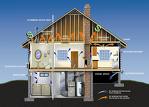Home > Technology > Air sealing
Air Sealing

Air sealing is the process of sealing gaps, cracks, and openings in a building's envelope to prevent air leaks. It is a crucial step in improving energy efficiency, indoor comfort, and indoor air quality. By sealing air leaks, energy loss is reduced, leading to lower energy bills. Air sealing also helps maintain a consistent temperature throughout the house and minimizes drafts. It plays a significant role in enhancing indoor air quality by preventing the entry of outdoor pollutants and allergens. Common air leakage points include windows, doors, attics, walls, and basements. Techniques such as caulking, weatherstripping, spray foam insulation, and gaskets are used for air sealing. Professional assistance is recommended for comprehensive air sealing projects. Overall, air sealing is a cost-effective measure that contributes to a more energy-efficient and comfortable home.
I. Purpose of Air Sealing:
• Energy Efficiency: Air leaks in a house can lead to significant energy loss as conditioned air escapes and outdoor air infiltrates. This can cause the heating and cooling systems to work harder, resulting in increased energy consumption and higher utility bills. By sealing air leaks, energy efficiency is improved, and energy costs are reduced.
• Indoor Comfort: Air leaks can create drafts, temperature inconsistencies, and discomfort in different areas of the house. By effectively sealing these leaks, the house becomes more comfortable, with fewer drafts and more consistent temperatures throughout.
• Indoor Air Quality: Air leaks can allow outdoor pollutants, allergens, and contaminants to enter the house, affecting the indoor air quality. By sealing air leaks, the entry of these pollutants is minimized, leading to cleaner and healthier indoor air.
II. Common Air Leakage Points:
• Windows and Doors: Gaps around windows and doors, worn-out weatherstripping, and poorly fitting frames are common sources of air leaks. Proper sealing of these areas can significantly reduce air infiltration.
• Attic and Roof: Unsealed attic hatches, gaps around chimneys, vents, and exhaust fans, as well as insufficient insulation in the attic, can contribute to air leakage. Sealing these areas helps prevent heat loss in winter and heat gain in summer.
• Walls: Wall penetrations for pipes, electrical outlets, and switches can create openings for air to leak through. Proper sealing of these penetrations helps minimize air leaks.
• Basement and Crawl Spaces: Gaps in foundation walls, unsealed joints, and unsealed penetrations in the basement or crawl space can allow air to enter or escape. Sealing these areas helps maintain a more controlled indoor environment.
III. Air Sealing Techniques and Materials:
• Caulking: Silicone or acrylic caulk is commonly used to seal gaps and cracks in stationary materials like window frames, door frames, baseboards, and wall joints.
• Weatherstripping: Weatherstrips are applied to movable components such as windows and doors to create a tight seal when closed.
• Spray Foam Insulation: Expanding spray foam insulation is used to seal larger gaps, cracks, and cavities. It can effectively fill irregular or hard-to-reach spaces.
• Gaskets and Sealants: Gaskets and sealants are applied around electrical outlets, switches, and other wall penetrations to prevent air leaks.
• Insulation: Proper insulation in walls, ceilings, and floors helps reduce air leakage by providing a barrier against air movement. Insulation materials such as fiberglass, cellulose, or foam insulation boards can be used.
IV. Benefits of Air Sealing:
• Energy Savings: Effective air sealing reduces the amount of energy required to heat or cool the house, resulting in lower energy bills.
• Enhanced Comfort: By sealing air leaks, drafts and temperature fluctuations are minimized, leading to a more comfortable indoor environment.
• Improved Indoor Air Quality: Air sealing helps prevent the entry of outdoor pollutants, allergens, and dust, resulting in better indoor air quality.
Soundproofing: Air sealing can also contribute to reducing noise transmission from outside, creating a quieter living space.
V. Professional Assistance:
• While some air sealing tasks can be done by homeowners, it is recommended to seek professional assistance, especially for more extensive projects or if the house has complex air leakage issues.
• Professional energy auditors or contractors can perform a blower door test to assess the extent of air leakage and identify specific areas that need sealing. They can provide expert advice and use specialized equipment and materials to ensure effective air sealing.
Air sealing in houses is a vital step in improving energy efficiency, indoor comfort, and indoor air quality. By sealing gaps, cracks, and openings, air leaks are minimized, resulting in lower energy costs, increased comfort, and a healthier living environment.









